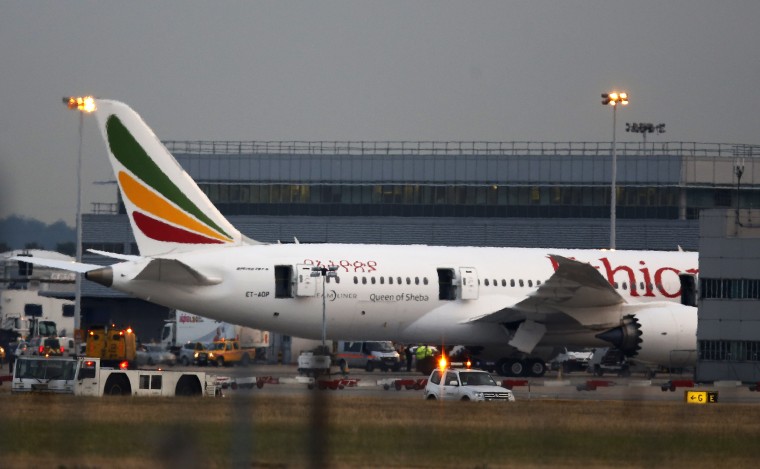LONDON — Investigators on Wednesday called for a safety review of lithium battery-powered equipment on planes after a fire on a parked Boeing 787 Dreamliner two years ago that flight attendants would have struggled to contain in the air.
The blaze tore through an empty Ethiopian Airlines jet at London’s Heathrow Airport in July 2013, burning a hole in the fuselage and filling the cabin with acrid smoke.
Britain’s Air Accident Investigations Branch concluded in a report Wednesday that the fire was caused by “crossed and trapped” wires in the lithium battery powering the emergency locator transmitter, or ELT, the “pinger” beacon that helps track missing aircraft.
Contact between the wires caused a short circuit and a thermal “runaway” in which the battery overheated and caught fire, generating toxic fumes, the report said. The fire spread to the fuselage, which is made of composite material.
Urgent checks were carried out on other Boeing 787s after the accident, resulting in the discovery of at least three other instances of crossed ELT battery wires.
The plane was deemed safe, but investigators now say there are concerns that other on-board equipment powered by the same type of battery could be at risk.
The investigators called on the U.S. Federal Aviation Administration to lead regulators in Canada and Europe in deciding whether such devices have sufficient protection against the effects of short circuits.
The AAIB also wants Boeing to speed up tests on how toxic smoke from an ELT battery fire would spread through the state-of-the-art system that controls cabin air in the Dreamliner.
The report could lead to further design changes for the troubled 787, which has been dogged by problems since it entered service in 2011 after long production delays.
The July 2013 fire shut Heathrow for 90 minutes and caused major delays. But the outcome could have been much worse if the plane had been in the air.
The AAIB said that tackling an ELT fire during a flight “would be challenging” for flight attendants because of the transmitter’s “inaccessible location” above the rear of the cabin, just under the outer skin of the fuselage.
“Gaining access to the ELT, which may require the removal of cabin ceiling panels, and getting close enough to make the use of a fire extinguisher effective, would be challenging," the report said. "Without specific training it is unrealistic for a member of the cabin crew to perform this task.”
In fact, the report added, opening ceiling panels “could feed the fire with oxygen and invigorate it.” Flight attendants would have to stand on a seat, or an arm rest, to aim a fire extinguisher at the source of the blaze.
In a statement, Boeing spokesman Paul R. Bergman said: "The final report by the AAIB is extensive and thorough, and we appreciate the effort put into the investigation."
The manufacturer promised to "carefully review the AAIB’s recommendations," but added: "It is important that any potential changes to the airplane’s design be reviewed with great care, and with due consideration for any potential unintended consequences of any change. We will work closely with regulators, operators and industry partners to ensure that the safety of the world’s commercial jetliners continues at the highest levels."
The statement added: "The safety of passengers and crew members who fly aboard Boeing airplanes is our highest priority.We are confident the 787 is safe and we stand behind its overall integrity."
The FAA did not respond to a request for comment.

